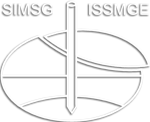Modeling solubility of a phosphogypsum-clay liner in contact with different pore liquids
Modeling solubility of a phosphogypsum-clay liner in contact with different pore liquids
Phosphogypsum is a by-product of the fertilizer industry, composed mainly of gypsite, whose suitable behavior in mixtures with soils has encouraged its use as a material for the construction of liners for sanitary landfills. This study investigated, through geochemical modeling, carried out by the PHREEQC software, how the solubility of a phosphogypsum-clay liner is affected by the interaction with water and leachate typical of sanitary landfills. The simulations were carried out assuming a 1 m thick liner subjected to the flow of water and leachate corresponding to the acidic, methanogenic, and mature phases of a sanitary landfill. The results indicated that the dissolution of gypsite was faster in the presence of leachate than in water, with accumulation of precipitated material in the lower layers and increased porosity in the upper layers of the liner. It was estimated that 50% of the gypsum content in the liner would dissolve after 48 pore volume of leachate flow and after 64 pore volume of water flow, as well as a 14% increase in total porosity after complete dissolution of the gypsite, leading to the conclusion that solubility must definitely be taken into account for PG to be employed in liners of sanitary landfills or in geotechnical layers where flow occurs.
Y. Isaias da Silva Borges; M. Eugenia Gimenez Boscov; M. Maria dos Anjos Mascarenha
9th International Congress on Environmental Geotechnics (ICEG2023)
Engineered Barriers
Geoenvironmental Engineering, Groundwater & Seepage, Landfill Engineering, Numerical & Constitutive Modeling
https://doi.org/10.53243/ICEG2023-233
